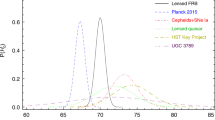Abstract
IN cosmological models based on the standard Friedmann–Robertson–Walker geometry, the apparent flux density or angular size of standard candles or standard rods varies with redshift in a way that depends on the deceleration parameter q0. (Open universes have q0 < 0.5; closed universes have q0 > 0.5.) At low redshift, however, observational errors are much greater than the differences in q0 expected for different cosmological models, while at high redshift observational uncertainties, particularly at optical wavelengths, and apparent systematic evolutionary changes in sources obscure the expected geometrical effects. Here I show that measurements by very-long-baseline interferometry (VLBI) of compact radio sources associated with active galaxies and quasars may be largely free of evolutionary effects even at substantial redshifts. The relation between angular size and redshift for a sample of these sources indicates a value of q0 close to 0.5, corresponding to cosmological density near the critical value.
Similar content being viewed by others
References
Hoyle, F. in Paris Symp. Radio Astronomy, IAU Symp. No 9 (ed. Bracewell. R.) 529–532 (1959).
Sandage, A. R. Astrophys. J. 133, 355–392 (1961).
Sandage, A. R. Astrophys. J. 173, 485–499 (1973).
Sandage, A. R. A. Rev. Astr. Astrophys. 26, 561–630 (1988).
Miley, G. K. Mon. Not. R. astr. Soc. 152, 477–489 (1970).
Legg T. H. Nature 226, 65–67 (1970).
Wardle, J. F. C. & Miley, G. K. Astr. Astrophys. 30, 305–315 (1974).
Kapahi, V. K. in Observational Cosmology. IAU Symp. No. 124 (ed. Hewitt. A. Burbidge, G. & Fang, L. Z.) 251–265 (1987).
Oort, M. J. A., Katgert, P., Steeman, F. W. M. & Windhorst, R. A. Astr. Astrophys. 179, 41–59 (1987).
Singal, A. K. Mon. Not. R. astr. Soc. 233, 87–113 (1988).
Kapahi, V. K. Astr. J. 97, 1–9 (1989).
Gopal-Krishna & Wiita, P. J. Astrophys. J. 373, 325–335.
Subramanian, K. & Swarup, G. Mon. Not. R. astr. Soc. 247, 237–243.
Cohen, M. H. in BL Lac Objects (ed. Maraschi, L., Maccacaro, T. & Ulrich, M.-H.) 13–21 (1989).
Pearson, T. J. in Parsec Scale Radio Jets (ed. Zensus, A.) 1–12 (1990).
Pearson, T. J. & Readhead, A. C. S. Astrophys. J. 328, 114–142 (1988).
Wilkinson, P. N., Polatidis, A., Readhead, A. C. S., Xu, W. & Pearson, T. J. in Sub Arc Second Radio Astronomy (ed. Davis, R. J.) (Cambridge Univ. Press, in the press).
Gurvits, L. I. et al. Astr. Astrophys. 260, 82–88 (1992).
Ekhart, A. et al. Astr. Astrophys. Suppl. Soc. 67, 121–146 (1987).
Wehrele, A. et al. Astrophys. J. 391, 589–607 (1992).
Kellermann, K. I., Sramek, R., Schmidt, M. & Shaffer, D. B. Astr. J. 98, 1195–1207 (1989).
Fanaroff, B. L. & Riley, J. M. Mon. Not. R. astr. Soc. 167, 31p–35p (1974).
Author information
Authors and Affiliations
Rights and permissions
About this article
Cite this article
Kellermann, K. The cosmological deceleration parameter estimated from the angular-size/redshift relation for compact radio sources. Nature 361, 134–136 (1993). https://doi.org/10.1038/361134a0
Received:
Accepted:
Issue Date:
DOI: https://doi.org/10.1038/361134a0
- Springer Nature Limited
This article is cited by
-
Multiple measurements of quasars acting as standard probes: Model independent calibration and exploring the dark energy equation of states
Science China Physics, Mechanics & Astronomy (2021)
-
The quasi-steady state cosmology: Theory and observations
Pramana (1999)





